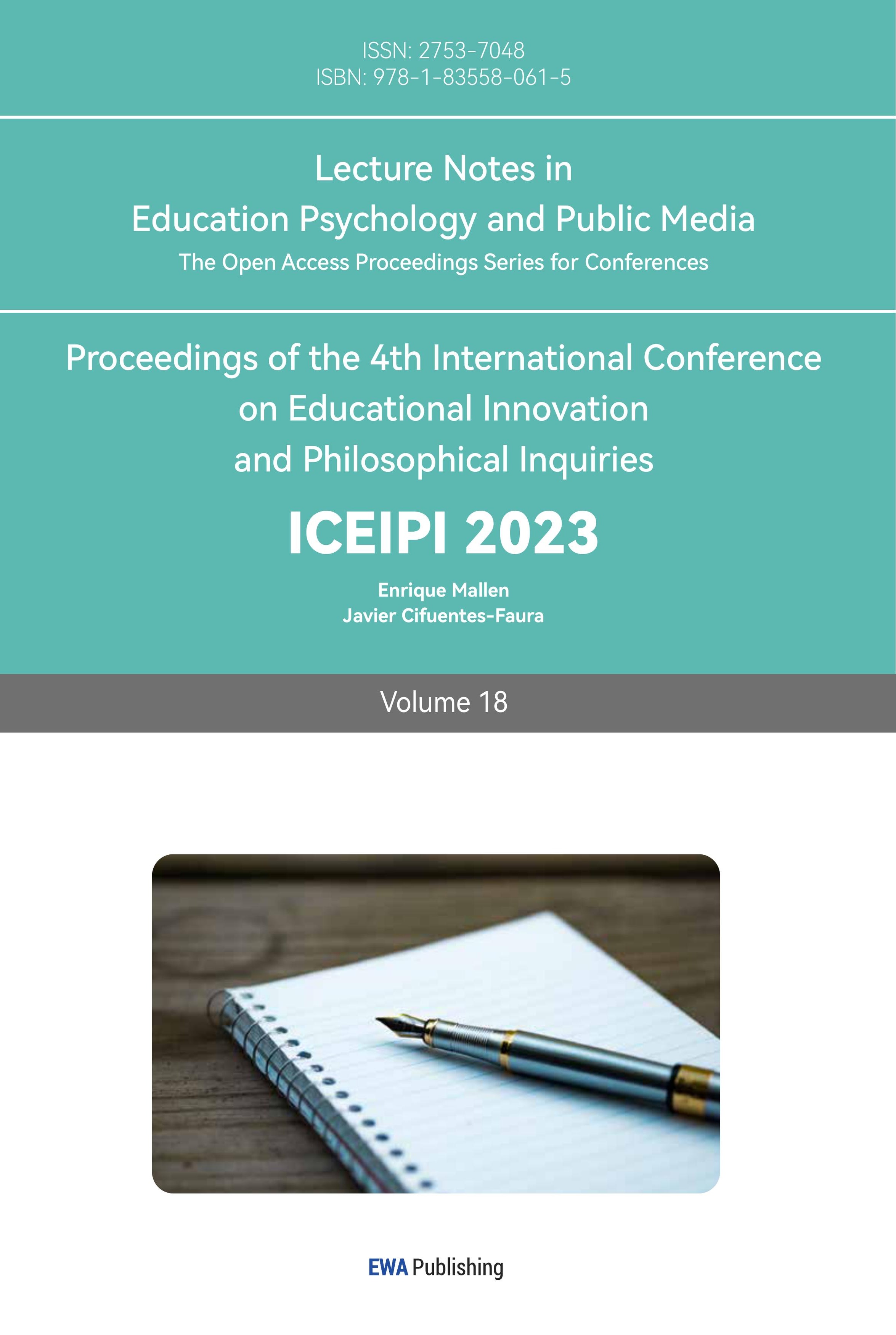References
[1]. Xie Junjun (2017). Research on the “Education Immigration” Policy in Ethnic Minority Areas - Taking Baoting Li and Miao Autonomous County in Hainan Province as an Example Frontier (10), 61-71.
[2]. Zhou Xiaogang, Wang Yimeng, Tao Shuang & Lin Rui. (2023). Poverty alleviation through Education: A Study on Intergenerational transmission of poverty in Chinese families based on Logistics Model. Journal of Yichun University (01),105-110.
[3]. An Yu (2020). Reconciliation of Education Cognition and Local Knowledge in Tibetan Ecological Immigration Schools Journal of Yunnan University for Nationalities (Philosophy and Social Sciences Edition) (06), 48-53.
[4]. Zhong Hua, Gu Yuxuan, Xiao Zhuoli&Zheng Huiting (2022). Rethinking Rural Boarding Schools in China: Social Bonding, Self Efficacy, and Academic Performance of Left and Non Left Rural Adolescents Hubei Social Sciences (12), 42-50.
[5]. Huang Xinxin, Li Yuting, Chen Jianhua, Ma Jingjing, Cong Enchao&Xu Yifeng (2023). The influence of family structure on adolescent depression and anxiety symptoms: the mediating role of emotional neglect Chinese Journal of Contemporary Pediatrics (01), 80-85.
[6]. Zeng Sulin, Li Jiaojiao, Hou Weihao&Peng Dongping (2020). The Realistic Dilemma and Breakthrough of Rural Teacher Motivation in the Context of Rural Revitalization Educational Theory and Practice (10), 40-44.
[7]. Pieh, C., Dale, R., Jesser, A., Probst, T., Plener, P. L., & Humer, E. (2022, January). The impact of migration status on adolescents’ mental health during COVID-19. In Healthcare (Vol. 10, No. 1, p. 176). Multidisciplinary Digital Publishing Institute.
[8]. Mehri, S. (2022). The problem of social adaptation of migrant adolescent children. International journal of social science & interdisciplinary research ISSN: 2277-3630 Impact factor: 7.429, 11(05), 108-113.
[9]. Maunah, B. (2019). The contribution of family and community education in realizing the goals of school education. American Journal of Education and Learning, 4(2), 292-301.
[10]. Ma Weinan. (2022). Construction of an evaluation system for vocational education poverty alleviation from the perspective of common prosperity. Vocational and Technical Education in China (33),89-96.
[11]. Yang Junkai. (2023). Practice path of deepening education poverty alleviation embedded mechanism in vocational colleges. Journal of Hubei Open Vocational College (04),75-76+79.
Cite this article
Ji,Y. (2023). Research on the Phenomenon of Educational Migration in China. Lecture Notes in Education Psychology and Public Media,18,33-39.
Data availability
The datasets used and/or analyzed during the current study will be available from the authors upon reasonable request.
Disclaimer/Publisher's Note
The statements, opinions and data contained in all publications are solely those of the individual author(s) and contributor(s) and not of EWA Publishing and/or the editor(s). EWA Publishing and/or the editor(s) disclaim responsibility for any injury to people or property resulting from any ideas, methods, instructions or products referred to in the content.
About volume
Volume title: Proceedings of the 4th International Conference on Educational Innovation and Philosophical Inquiries
© 2024 by the author(s). Licensee EWA Publishing, Oxford, UK. This article is an open access article distributed under the terms and
conditions of the Creative Commons Attribution (CC BY) license. Authors who
publish this series agree to the following terms:
1. Authors retain copyright and grant the series right of first publication with the work simultaneously licensed under a Creative Commons
Attribution License that allows others to share the work with an acknowledgment of the work's authorship and initial publication in this
series.
2. Authors are able to enter into separate, additional contractual arrangements for the non-exclusive distribution of the series's published
version of the work (e.g., post it to an institutional repository or publish it in a book), with an acknowledgment of its initial
publication in this series.
3. Authors are permitted and encouraged to post their work online (e.g., in institutional repositories or on their website) prior to and
during the submission process, as it can lead to productive exchanges, as well as earlier and greater citation of published work (See
Open access policy for details).
References
[1]. Xie Junjun (2017). Research on the “Education Immigration” Policy in Ethnic Minority Areas - Taking Baoting Li and Miao Autonomous County in Hainan Province as an Example Frontier (10), 61-71.
[2]. Zhou Xiaogang, Wang Yimeng, Tao Shuang & Lin Rui. (2023). Poverty alleviation through Education: A Study on Intergenerational transmission of poverty in Chinese families based on Logistics Model. Journal of Yichun University (01),105-110.
[3]. An Yu (2020). Reconciliation of Education Cognition and Local Knowledge in Tibetan Ecological Immigration Schools Journal of Yunnan University for Nationalities (Philosophy and Social Sciences Edition) (06), 48-53.
[4]. Zhong Hua, Gu Yuxuan, Xiao Zhuoli&Zheng Huiting (2022). Rethinking Rural Boarding Schools in China: Social Bonding, Self Efficacy, and Academic Performance of Left and Non Left Rural Adolescents Hubei Social Sciences (12), 42-50.
[5]. Huang Xinxin, Li Yuting, Chen Jianhua, Ma Jingjing, Cong Enchao&Xu Yifeng (2023). The influence of family structure on adolescent depression and anxiety symptoms: the mediating role of emotional neglect Chinese Journal of Contemporary Pediatrics (01), 80-85.
[6]. Zeng Sulin, Li Jiaojiao, Hou Weihao&Peng Dongping (2020). The Realistic Dilemma and Breakthrough of Rural Teacher Motivation in the Context of Rural Revitalization Educational Theory and Practice (10), 40-44.
[7]. Pieh, C., Dale, R., Jesser, A., Probst, T., Plener, P. L., & Humer, E. (2022, January). The impact of migration status on adolescents’ mental health during COVID-19. In Healthcare (Vol. 10, No. 1, p. 176). Multidisciplinary Digital Publishing Institute.
[8]. Mehri, S. (2022). The problem of social adaptation of migrant adolescent children. International journal of social science & interdisciplinary research ISSN: 2277-3630 Impact factor: 7.429, 11(05), 108-113.
[9]. Maunah, B. (2019). The contribution of family and community education in realizing the goals of school education. American Journal of Education and Learning, 4(2), 292-301.
[10]. Ma Weinan. (2022). Construction of an evaluation system for vocational education poverty alleviation from the perspective of common prosperity. Vocational and Technical Education in China (33),89-96.
[11]. Yang Junkai. (2023). Practice path of deepening education poverty alleviation embedded mechanism in vocational colleges. Journal of Hubei Open Vocational College (04),75-76+79.









